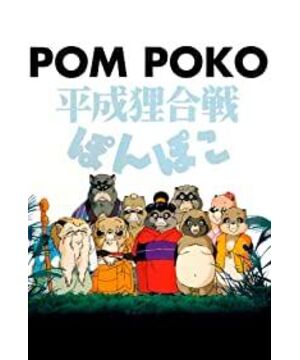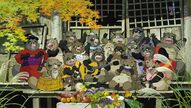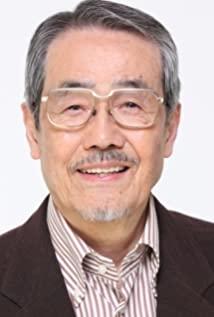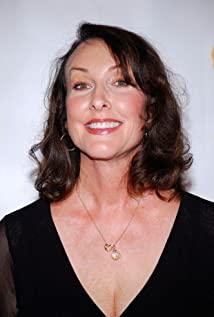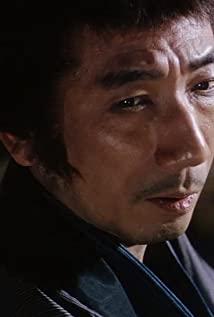How to evaluate Takahata Hoon's animation works?
In fact, compared with Hayao Miyazaki’s influence in Studio Ghibli, Takahata’s influence on world animation is no less than that of the former, but at the same time the two seem a bit embarrassing to compare. When "Princess Mononoke" and "Thousand" While "Chihiro" created box office myths one after another, Takahata's works continued to encounter "troughs". "My Neighbor Yamada-kun" and "Kaguya Hime Monogatari" did not recover the cost. After "Yamada-kun" Takahata Moreover, no new works have been published in 14 years, which is a big blow.
Even though they are already master animation directors in Ghibli and even the world, the works of Hayao Miyazaki and Takahata are quite different in content. You might as well make money from "The Variety Tanuki", the last film of Takahata. Speaking of works.
In fact, I thought about a lot of things before watching this movie. Except for "Yamada-kun" (because I haven't watched it yet), "The Variety Tanuki" is actually the first "fantasy" movie in the true sense of Takahata Hoon. , "The Tomb of Fireflies" are mostly realistic scenes, "The Fairy Tale of the Years" can be directly shot live-action respectively, "Kaguya Ji Monogatari" such "mythical" works, most of the time is also in the world of Kaguya Ji The story unfolds. In "The Variety of Tanuki", the protagonist of the story is a group of relaxed and happy civet cats. They have confronted humans... This kind of story sounds more like a Hollywood film, a story about people and nature. A fairy tale of confrontation between.
But in fact, I was wrong. Many details in "The Variety of Tanuki" make me think about the good and the bad.
The beginning of "Variety Tanuki" is particularly cute and childlike. A group of realistic tanukis face each other in the woods. At the moment they charge to the front, their feet lifted up and turned into human figures, wearing a Japanese samurai. Like many cartoon characters in anime, their armor began to bounce around. What’s more interesting is that when the civet cat is defeated, their character images become childlike graffiti, lying on the ground softly. It can be seen that in the movie, the image of the civet cat was carefully considered. When they were fighting, the "mother-in-law" dressed in a kimono suddenly disrupted the battle, and looked like a house owner. People can't help but laugh.
One of the civet cat’s stunts is transformation. The highly skilled civet cat can transform into a human form, and some delicious and lazy civet cats will always show their stuff when they transform. The story of the street can make people leaning forward and backward with laughter. Including the previous meetings, training, and practice, the director seems to want to explain to us that these civet cats are also very flawed. They will always start habitual gatherings when one thing is done (or not yet completed). Eat and drink, no matter what, like a middle-aged man who loves to drink, drink until he gets dizzy and sleeps until tomorrow morning. They eat and do things lazily, and would rather stare at the fruit on the tree than to themselves They were interested in the transformation of life and death; they lacked discipline, and when they were silent for the dead humans, everyone couldn’t help but laughed and continued to celebrate on the grass regardless of the opposition of the mother-in-law and the monk. Even among them, there were often conflicts and the main battle The pie and the master and the pie are always arguing.
In fact, a careful audience will find that Takahata Hoon’s ambitions in "The Variety of Tanuki" obviously go beyond the relationship between man and nature, because if it is just to call everyone to pay attention to environmental protection, these details will not appear. In these descriptions, I need to specifically pull out the story of the civet cats deliberately causing accidents on the site. The leader of the Red Army, Quantai, is a very radical civet cat. He advocated that civet cats should use their own power to destroy humans and regain their forests. And he caused several serious car accidents. Three drivers died as a result. Then they celebrated frantically on the grass. They were impatient and didn't even hold back the silence.
I don’t know if it was Takahata Hoon deliberately, but I couldn’t help wiping my cold sweat. I believe that the audience felt uncomfortable when watching this joyous celebration, because from our perspective, what is the guilt of these dead drivers? Woolen cloth? But the director even used joyous scenes to emphasize this process, which led the film to a path of dangerous moral discussion. But this kind of moral problem has appeared many times in the works of Director Takahata Hoon. What is interesting is that he has not avoided it once: the little girl in "The Tomb of Fireflies" under the stubborn attitude of her brother to be lazy and not to survive, Eventually the girl’s death was caused; in "Kaguya Ji Monogatari", the heroine hooked up with a man with a wife and children, and also initiated a romantic chapter of elopement; even in the very gentle "Fairy Tales of the Years", Taeko The things that I recall are actually not good, and most of these memories have not been resolved in reality, such as the slap my father slapped. In Takahata's story, there are no particularly memorable animated characters. In Miyazaki's animation, he portrays spiritual and brave girls and boys, which are rare in Takahata's pen.
In fact, this seems to explain why Miyazaki’s animation is more popular than Takahata’s animation. In addition to the epic background in Miyazaki’s animation, Miyazaki’s characters: Chihiro, Asidaka, Kiki, etc. They are all loving and positive characters in their hearts. This is the image that viewers, especially children, most want to see in cartoons.
Comparing the animation worlds of Hayao Miyazaki and Takahata is actually a very long process. I just cite a few examples in a hurry, I don't dare to go into more details. Back in the movie, the transformed civet cat opened the eyes of the audience, and the story of the civet cat acting as a ghost is also very funny. But every time the civet cats meet a human, they will change back to the original civet body, just like the civet cat in life. The movie seems to have been emphasizing this point. In the film, even the birth of a doll between a male civet cat and a female civet cat is also used to express realistically. It is the perspective of the audience and their civet cats. This seems to tell us that from a human point of view, their image is a normal civet cat. The two lines are of the same world. Takahata deliberately said in the narration that began the civet war: "When there are no humans, the civet cats stand upright. Walking.” He expressed tirelessly: The fairy tale world of the civet cats can be explained by the thinking of human society, but I drew it into the form of animation in the animation by Takahata.
But I couldn't help but wonder, is this really a form that cartoons can carry?
Kids and friends who have watched "Toy Story" know that the toys in the story all live in the human world. The fairy tale world we see is very similar to Takahata's "Variety Tanuki", and both have always existed. The human world is interfering with the elements of the fairy tale world in the movie, but even then the world of "Toy Story" is still romanticized, and watching "Various Tanuki" always feels a bit awkward, because Takahata Hoon has been using real and cruel The world is testing this group of civet cats, including Mr. Fox showing the colorful world of Tokyo to the elders with round glasses, and the beauties around the elders, who look particularly dazzling and uncomfortable. The human world in "Toy Story" is just sugar water, but this is just a cartoon, why bother about the truth and the unreal?
Let’s look at "Fantasy New Sons and Thousand-Year Magic", which is used to shooting reality and magic. The whimsical ideas in Xinzi’s head and the sadness of reality contrast with each other, but Katabuchi just clicks to the end. He took his companion's little hand and crossed the field. The goodness at that time has passed through the sadness. It is trying to make reconciliation with those unhappy things. What a beautiful moment! But in "The Variety of Tanuki", the emotions in the story are very complicated, and it is also powerless for Tanuki to solve. Therefore, it can neither solve these problems nor make a reconciliation. These civet cats go with the eggs. Like hitting a stone, the civet cat, who will not transform, follows the elders and accompanies the joyous music, drove the boat to the Paradise of Elysium, or they transform and hide in the crowded Tokyo, in front of an ordinary office worker, The thinking contained in it has actually reached the subject of "cultural conflict". "Variety Tanuki" is unable to carry such a mission, but in terms of the quality of the entire film, I don't think any director can be like Takahata Hoon. Complete this complicated story as well.
Reality, reality, this is Takahata's eternal proposition. The extremely gorgeous parade of ghosts and monsters initiated by the elders is gorgeous and gorgeous. This is a form that is only suitable for expression in animation. This massive parade is different from the last appearance of the beast god in Hayao Miyazaki's "Princess Mononoke" and "Spirited Away" The new and weird big bath in "Spirited Away" is a show to the city. It is rooted in reality, rather than creating a fantasy world out of thin air. What Takahata Hoon created is a strange world shaped by the life of a civet cat, expressing the state of urbanites who have been exhausted from imagination, with a little disappointment.
I mentioned two points earlier. The first is Takahata's direct response to the ethical problems encountered, and the second is to describe the real society as much as possible. In fact, they can be boiled down to one point, that is, "Takahata is not afraid to describe moral issues in real life in cartoons. Even if it does not seem to be suitable for expression in the form of cartoons, Takahata has no hesitation."
Like Hayao Miyazaki, he is very good at making use of the cute, jubilant, and child-friendly elements of cartoons, as well as a bit of evil (such as the testicles of the civet cat, which is really bad for the Japanese to think of). But in some of the story elements that break through the audience’s bottom line, Hayao Miyazaki uses beheaded and severed hands ("Princess Mononoke") cannibalism ("Spirited Away") disgusting enemies ("Nausicaa"), Takahata The choice is a question that seems to violate the norms of social behavior (ethical?). Compared with the challenge given by Hayao Miyazaki on the screen, Takahata seems more uncomfortable.
But this does not mean that Takahata's artistic creation direction is wrong. In fact, it can be digging here to explain the characteristics of Takahata's world-class animation master.
There is a big problem with "Various Tanuki": there is no protagonist. When I thought of this, I was really ashamed. How confident the creators are, dare to have no protagonist in a cartoon, and there are very few movies without villains! The perspective is fluttering, focusing on the irritable Kwon Tai, the mother-in-law and the monk grandfather, the civet cat with the protagonist portrait (even forgot the name... is that when you are very calm when speaking, you play a white-faced doll with your girlfriend. The little civet cat to scare the construction workers) appeared for dozens of minutes, and the story turned to the messenger rushing to the distance...The advantage of storytelling in this way is that it allows the audience to think about all aspects of the movie, but the fatal thing is The story has no main line and no motivation for the audience to watch it. So even if there are so many fun and whimsical ideas in the story, such a gorgeous picture, it still makes people unable to concentrate on watching it in the second half. But the story is narrated from the perspective of the main battle group, the main group, and Mr. Fox, providing one kind of thinking after another, which actually makes the film more interpretable angles.
So I am really emotional. I think that there are already a lot of thinking beyond animation in Hayao Miyazaki's animation. However, Takahata Hoon’s ambitions in "The Variety Tanuki" are even greater-but is there any problem in the direction of his efforts? I I think there are still some.
So although the ending is touching, it is actually just to give a nice ending. Mr. Fox's clues are gone. It can't solve some of the problems in the story, so it's a pity. I'm actually very curious. "The Variety of Tanuki" was released in Japan and received a box office of 4 billion yen. Do you really like this work so much?
Unexpectedly, I have gained a lot from watching "The Variety Civet", but in summary, it is still more regret than surprise. For such a persistent Takahata Hoon, I thank you two years late for the touch and thought you have brought me. It’s just a pity that during the 14-year window period between 1999 and 2013, you didn’t create more animation works. It’s really regrettable.
View more about Pom Poko reviews


